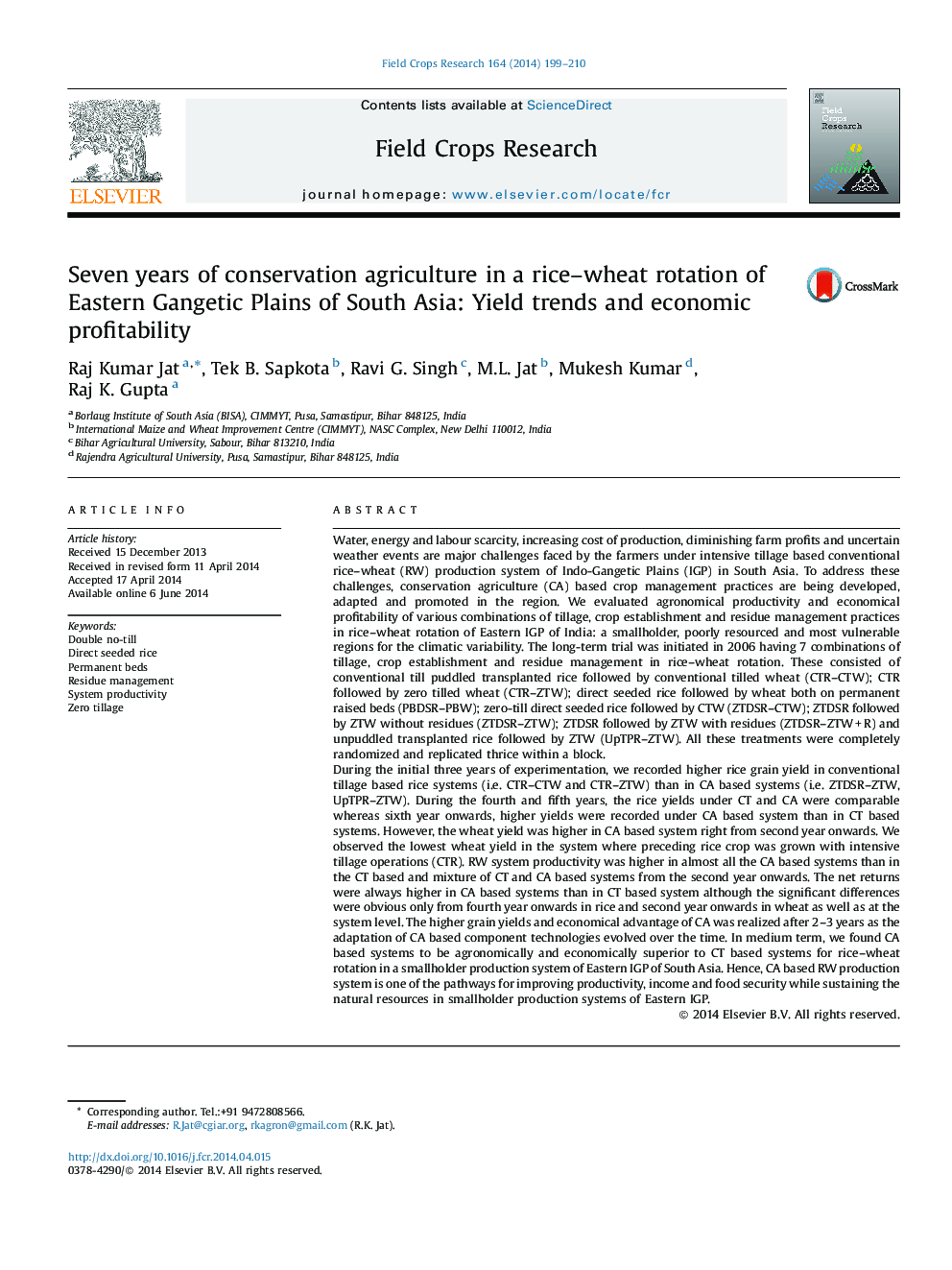| کد مقاله | کد نشریه | سال انتشار | مقاله انگلیسی | نسخه تمام متن |
|---|---|---|---|---|
| 4510100 | 1624699 | 2014 | 12 صفحه PDF | دانلود رایگان |
• Medium-term effect of conventional and conservation agriculture (CA) based management practices was evaluated in rice–wheat rotation of Eastern IGP.
• Yield and economical advantage of CA based system as compared to conventional tillage (CT) based system was more prominent 2–3 years after experimentation.
• Our seven years data show that CA based management systems are agronomically and economically superior to conventional systems under smallholder rice–wheat production system of Eastern IGP.
Water, energy and labour scarcity, increasing cost of production, diminishing farm profits and uncertain weather events are major challenges faced by the farmers under intensive tillage based conventional rice–wheat (RW) production system of Indo-Gangetic Plains (IGP) in South Asia. To address these challenges, conservation agriculture (CA) based crop management practices are being developed, adapted and promoted in the region. We evaluated agronomical productivity and economical profitability of various combinations of tillage, crop establishment and residue management practices in rice–wheat rotation of Eastern IGP of India: a smallholder, poorly resourced and most vulnerable regions for the climatic variability. The long-term trial was initiated in 2006 having 7 combinations of tillage, crop establishment and residue management in rice–wheat rotation. These consisted of conventional till puddled transplanted rice followed by conventional tilled wheat (CTR–CTW); CTR followed by zero tilled wheat (CTR–ZTW); direct seeded rice followed by wheat both on permanent raised beds (PBDSR–PBW); zero-till direct seeded rice followed by CTW (ZTDSR–CTW); ZTDSR followed by ZTW without residues (ZTDSR–ZTW); ZTDSR followed by ZTW with residues (ZTDSR–ZTW + R) and unpuddled transplanted rice followed by ZTW (UpTPR–ZTW). All these treatments were completely randomized and replicated thrice within a block.During the initial three years of experimentation, we recorded higher rice grain yield in conventional tillage based rice systems (i.e. CTR–CTW and CTR–ZTW) than in CA based systems (i.e. ZTDSR–ZTW, UpTPR–ZTW). During the fourth and fifth years, the rice yields under CT and CA were comparable whereas sixth year onwards, higher yields were recorded under CA based system than in CT based systems. However, the wheat yield was higher in CA based system right from second year onwards. We observed the lowest wheat yield in the system where preceding rice crop was grown with intensive tillage operations (CTR). RW system productivity was higher in almost all the CA based systems than in the CT based and mixture of CT and CA based systems from the second year onwards. The net returns were always higher in CA based systems than in CT based system although the significant differences were obvious only from fourth year onwards in rice and second year onwards in wheat as well as at the system level. The higher grain yields and economical advantage of CA was realized after 2–3 years as the adaptation of CA based component technologies evolved over the time. In medium term, we found CA based systems to be agronomically and economically superior to CT based systems for rice–wheat rotation in a smallholder production system of Eastern IGP of South Asia. Hence, CA based RW production system is one of the pathways for improving productivity, income and food security while sustaining the natural resources in smallholder production systems of Eastern IGP.
Journal: Field Crops Research - Volume 164, 1 August 2014, Pages 199–210
